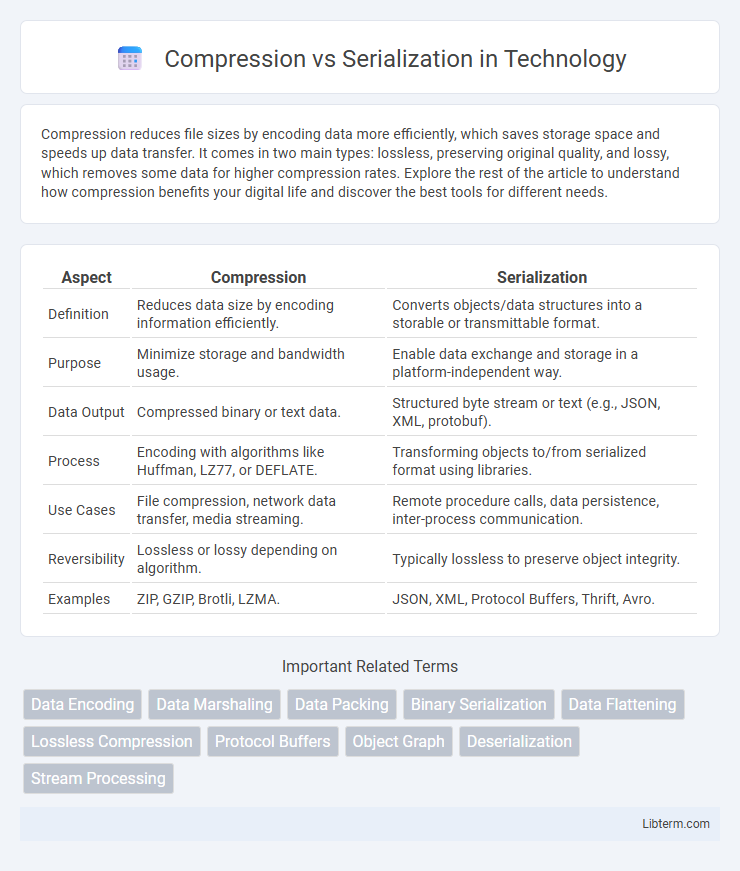Compression reduces file sizes by encoding data more efficiently, which saves storage space and speeds up data transfer. It comes in two main types: lossless, preserving original quality, and lossy, which removes some data for higher compression rates. Explore the rest of the article to understand how compression benefits your digital life and discover the best tools for different needs.
Table of Comparison
| Aspect | Compression | Serialization |
|---|---|---|
| Definition | Reduces data size by encoding information efficiently. | Converts objects/data structures into a storable or transmittable format. |
| Purpose | Minimize storage and bandwidth usage. | Enable data exchange and storage in a platform-independent way. |
| Data Output | Compressed binary or text data. | Structured byte stream or text (e.g., JSON, XML, protobuf). |
| Process | Encoding with algorithms like Huffman, LZ77, or DEFLATE. | Transforming objects to/from serialized format using libraries. |
| Use Cases | File compression, network data transfer, media streaming. | Remote procedure calls, data persistence, inter-process communication. |
| Reversibility | Lossless or lossy depending on algorithm. | Typically lossless to preserve object integrity. |
| Examples | ZIP, GZIP, Brotli, LZMA. | JSON, XML, Protocol Buffers, Thrift, Avro. |
Introduction to Data Compression and Serialization
Data compression reduces the size of data by encoding information more efficiently, optimizing storage and transmission bandwidth. Serialization converts complex data structures or objects into a format that can be easily stored or transmitted and later reconstructed. Both processes enhance data handling but serve different purposes: compression minimizes data volume, while serialization ensures data integrity across systems.
Definitions: What is Compression? What is Serialization?
Compression is the process of reducing the size of data by encoding information more efficiently to save storage space or decrease transmission time. Serialization is the technique of converting complex data structures or objects into a format that can be easily stored, transmitted, and reconstructed later, such as JSON, XML, or binary streams. While compression targets minimizing data size, serialization focuses on representing data in a structured, transferable form.
Core Differences Between Compression and Serialization
Compression reduces the size of data by encoding it more efficiently, focusing on minimizing storage space or transmission time without altering the data's structure. Serialization transforms complex objects or data structures into a linear format that can be easily stored or transmitted and later reconstructed into the original form. Unlike serialization, which preserves data integrity and structure, compression prioritizes data size reduction and may require decompression to regain the original data.
Common Use Cases for Compression
Compression is widely used in reducing file sizes for storage optimization and faster data transfer across networks, especially in multimedia files, backups, and archives. It helps minimize bandwidth usage in web applications by compressing HTTP responses such as HTML, CSS, and JavaScript files. Data compression is also critical in cloud storage and big data processing, enabling efficient resource management and cost savings.
Common Use Cases for Serialization
Serialization is commonly used in scenarios requiring data transfer across network protocols such as HTTP and WebSocket, enabling objects to be converted into byte streams for efficient communication between distributed systems. It plays a critical role in persistent storage solutions, where complex data structures must be saved and retrieved from databases or files while maintaining their integrity and state. Serialization also facilitates Remote Procedure Calls (RPC) and inter-process communication by ensuring data compatibility across diverse programming environments and hardware platforms.
Performance Impacts: Speed and Storage
Compression reduces data size by encoding information more efficiently, often requiring additional processing time but significantly saving storage space and bandwidth. Serialization converts complex objects into a format suitable for storage or transmission, focusing on structural fidelity, typically offering faster processing speeds but resulting in larger data sizes compared to compression. Optimizing performance requires balancing compression algorithms' computational overhead against the serialization method's speed and the storage or network constraints of the application environment.
Popular Tools and Libraries for Compression and Serialization
Popular compression tools include gzip, Zstandard (zstd), and LZ4, known for their high-speed and efficient data reduction capabilities. Serialization libraries like Protocol Buffers, Apache Avro, and JSON are widely used for converting complex data structures into compact, transportable formats. Combining serialization formats with compression algorithms, such as using Protocol Buffers with gzip, often optimizes both data size and transmission speed in applications.
Data Integrity and Security Considerations
Compression reduces file size by encoding data more efficiently, but it does not inherently enhance data integrity or security, as compressed data can still be vulnerable to corruption and unauthorized access. Serialization converts complex data structures into a format suitable for storage or transmission, often integrating checksums or digital signatures to maintain data integrity and enable secure verification. Combining serialization with encryption and compression techniques optimizes data transmission efficiency while ensuring confidentiality and integrity in secure applications.
Choosing Between Compression and Serialization
Choosing between compression and serialization depends on the specific application requirements such as data size, speed, and interoperability. Serialization transforms complex objects into a byte stream for storage or transmission, optimizing data structure and accessibility, while compression reduces the size of already serialized data to save bandwidth and storage space. For scenarios requiring quick data access and manipulation, serialization is preferred; compression is ideal when minimizing data transfer costs or storage is critical.
Conclusion: Best Practices and Recommendations
Choosing between compression and serialization depends on specific use cases; serialization excels in converting complex objects into storable formats, while compression reduces data size for transmission efficiency. Best practices recommend using serialization to structure data efficiently before applying compression algorithms like gzip or zlib to optimize storage or network performance. Combining both techniques achieves minimal data footprint with preserved data integrity, crucial for scalable applications and high-speed data exchange.
Compression Infographic

 libterm.com
libterm.com